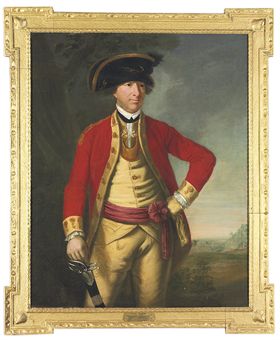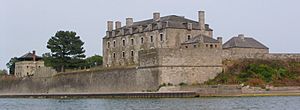Eyre Massey, 1st Baron Clarina facts for kids
Quick facts for kids
The Lord Clarina
|
|
|---|---|

Massey by Robert Hunter
|
|
| Born | 24 May 1719 Duntrileague, County Limerick, Kingdom of Ireland |
| Died | 17 May 1804 |
| Allegiance | |
| Service/ |
|
| Years of service | 1739–1804 |
| Rank | General |
| Commands held | 27th (Inniskilling) Regiment of Foot |
| Battles/wars | French and Indian War |
Eyre Massey, 1st Baron Clarina (born May 24, 1719 – died May 17, 1804) was an important British Army officer. He was born in Ireland, which was then part of the Kingdom of Great Britain. Massey is best known for his success at the Battle of La Belle-Famille during the French and Indian War. In 1800, he was given the title of Baron Clarina. This made him a member of the Peerage of Ireland, a special group of nobles.
Contents
Who Was Eyre Massey?
Eyre Massey was born in County Limerick, Ireland. He was one of many children born to Colonel Hugh Massey. In 1739, when he was 20 years old, he joined the 27th Foot regiment. This was a British Army group. He started as an ensign, a junior officer.
Massey's regiment went to the West Indies in 1739. They were part of the Battle of Porto Bello. This battle was fought against the Spanish. Only a few soldiers from his group survived. Massey continued to serve in the 27th Foot. He fought in Scotland from 1745 to 1746. He was promoted to captain in 1747. By 1755, he had become a major.
Massey in the French and Indian War

In 1757, Massey went to North America. He was a major in the 46th Foot regiment. The next year, he became a lieutenant-colonel. In 1759, his regiment joined an expedition to Niagara. During this mission, the British commander, Brigadier-General John Prideaux, was killed. Massey then took charge of the British troops.
Massey worked with Sir William Johnson, who led many Native American allies. Massey decided to let Johnson take the main command. This was because Johnson had a strong connection with the Native American groups.
The Battle of La Belle-Famille
Massey played a key role in the Battle of La Belle-Famille. He led about 500 soldiers from the 46th Foot and 400 Native American warriors. They faced a much larger French force. The French had 1,800 regular soldiers and Canadians, plus 500 Native American allies.
Massey's smaller force completely defeated the French. They captured almost all the French officers. This battle happened very close to Fort Niagara. Because of Massey's victory, Fort Niagara surrendered right after the battle. This win gave the British control over the entire Upper Ohio River Valley.
After this success, Massey asked to return to his old regiment, the 27th Inniskillings. He led the grenadiers, a special group of soldiers, during the advance on Montreal in 1760. He also fought in the capture of Martinique and the conquest of Havana in 1762. He was wounded several times during these campaigns.
Massey's Later Military Life
After the war ended, Massey commanded the 27th regiment. They were stationed in New York City and Quebec from 1763 to 1769. Later, they moved to Ireland. In 1773, he became the colonel of his regiment.
In 1776, Massey was sent to Nova Scotia as a Major-General. He commanded the troops in Halifax for four years. Later, he held a command in Cork, Ireland. He even created a plan to defend Cork in 1780.
For many years, Massey did not have a military command. He was also a Member of Parliament for Swords in the Parliament of Ireland from 1790 to 1797. He was disappointed that he wasn't given more military roles. In 1794, he finally got the Cork command again. He held this position until he became a full general in 1796.
Massey faced a challenge in 1795. About 2,000 young soldiers mutinied at Spike Island. He successfully put down this rebellion.
On December 27, 1800, Eyre Massey was given the title of Baron Clarina. He died on May 17, 1804, at the age of 85. At the time of his death, he was a full general. He was also the colonel of the 27th Inniskilling Foot, and held other important positions in Ireland.
Massey's Family
Eyre Massey married Catherine Clements. She was the sister of Robert Clements, 1st Earl of Leitrim. They had four children together. Two of his descendants also became generals. His second son, Nathaniel William, became the second Baron Clarina. He died as a major-general in 1810. His great-grandson, the fourth baron, also became a general. He fought in the Crimean War and the Indian Rebellion of 1857.
Family Coat of Arms
|

